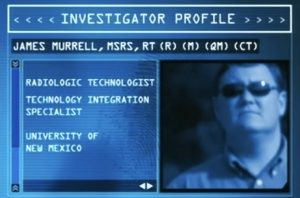By Cindy R. Chamberlin, Gurnick Academy of Medical Arts
Once upon a time, people thought King Tut had been “done in by a blow to the head,” as Science put it in 2005. It was radiology that closed the book on that supposition and radiology that posited other causes–a broken femur that got infected, for one.
And, it’s the specialized training in radiology and advanced imaging techniques that now enables the earlier detection of liver and heart diseases, precision targeting of tumors during radiation therapy, and guidance of cardiovascular interventions to reopen clogged arteries.
Tomorrow’s radiographers and radiologic technicians are training today with CAHL Platinum Sponsor Gurnick Academy. Gurnick’s combination of didactic and clinical education relies on instructors and faculty who are healthcare professionals currently active in their field of study–though some of their subjects haven’t been active since, say, 1324 BC.
Dean of Imaging Dr. James Murrell exemplifies the variety of life experiences Gurnick faculty infuse into their teaching of tomorrow’s healthcare leaders. In addition to master’s degrees in Executive Management and Leadership and in Radiologic Sciences, he also holds doctorates in Physics and Higher Education Administration.
And then there’s the mummies.

“Mummy Investigator” James Murrell in the Discovery series “Mummy Autopsy.”
Murrell’s many-faceted career ranges from serving as a Level I trauma radiographer and radiology director to being a mammographer to being a television star. Murrell served as a “Mummy Investigator” on the Discovery Channel series Mummy Autopsy. Here he used forensic science and the latest investigative techniques to unlock the human stories of mummies from across six continents.
It’s an experience he draws on today in his teaching and leadership roles. This past November, Murrell keynoted the California Society of Radiologic Technologists’ 84th-annual conference* with a session on “Imaging Our History Through Mummy Radiography.”
“I started teaching because I strongly believe in educational inquiry,” says Dr. Murrell. “I realized I had a knack for calming students while teaching courses that are often considered difficult, like physics and radiobiology.” He’s extended this commitment to his work with faculty and program directors on finding solutions to programmatic issues.
“One of my favorites is ensuring that every program with a programmatic accreditor receives that accreditation. I believe in our programs earning the highest level of accreditation, which sets our imaging programs apart from the rest of the community,” he says.
“Skeletons in The Closet” Bring Valued Diversity to Classroom Experiences
Gurnick believes that professors with diverse backgrounds like Murrell’s ultimately introduce students to different perspectives, even if it’s not every professor who has a mummy to pull from in their educational bag of tricks,
“The direct access to instructors that can teach following an approved curriculum of study and real-world clinical instruction that is actually in the field today is a best practice to broaden minds,” says David Kuhs, Gurnick’s Director of Career Services and Talent Acquisition. “This is enhanced through hands-on experience for students’ future healthcare careers.”
According to Kuhs, when Gurnick students enter the field after graduation and complete their licensure and certificates, they are prepared and ready to work. “Gurnick’s approach to hands-on education with qualified and passionate instructors, faculty, and affiliated clinical sites is a value added to our students and graduates,” he says. “Gurnick’s employers have stated that our graduates are qualified and not afraid to hit the ground running and come with the skills and confidence because of the many hours of both classroom and clinical practice in their fields of study.”
Professors like Murrell provide different cultural, social, and intellectual insights that challenge students’ preconceived notions and encourage critical thinking. Such unique educational journeys and research bring a fresh interdisciplinary approach to other staff and the student body.
*ARRT,® American Registry of Radiologic Technologists,® R.T.(MR)(ARRT),® and R.T.(T)(ARRT)® The American Registry of Radiologic Technologists own registered trademarks. Gurnick Academy is not licensed, endorsed, or affiliated with The American Registry of Radiologic Technologists.
This article was updated February 22 to reflect that Gurnick Academy trains future radiographers and radiologic technicians.
 Gurnick Academy works alongside educational partners within healthcare to provide committed, competent, and qualified medical professionals. Through collaboration with site rotations, employers can expect better-equipped graduates ready to hire upon graduation. Gurnick Academy and California Association of Healthcare Leaders (CAHL) have partnered to ensure a commitment of high caliber service for communities throughout California. As a CAHL member, individuals can seek out educational growth within nursing, medical imaging, and other allied-health career pathways. If you want to study under professors like Dr. Murrell and others, learn more by checking out Gurnick Academy’s list of available programs today.
Gurnick Academy works alongside educational partners within healthcare to provide committed, competent, and qualified medical professionals. Through collaboration with site rotations, employers can expect better-equipped graduates ready to hire upon graduation. Gurnick Academy and California Association of Healthcare Leaders (CAHL) have partnered to ensure a commitment of high caliber service for communities throughout California. As a CAHL member, individuals can seek out educational growth within nursing, medical imaging, and other allied-health career pathways. If you want to study under professors like Dr. Murrell and others, learn more by checking out Gurnick Academy’s list of available programs today.

